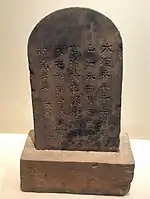Northern Liang (北涼) 建康 (397–399), 涼 (399–401, 431–433), 張掖 (401–412), 河西 (412–431, 433–441, 442–460), 酒泉 (441–442) | |||||||||||||||
|---|---|---|---|---|---|---|---|---|---|---|---|---|---|---|---|
| |||||||||||||||
Northern Liang and other Asian polities in 400 AD | |||||||||||||||
.jpg.webp) Northern Liang at its greatest extent in 436 AD | |||||||||||||||
| Status | Vassal of Later Qin, Eastern Jin, Northern Wei, Liu Song | ||||||||||||||
| Capital | Jiankang (397–398) Zhangye (398–412) Guzang (412–439) Jiuquan (440–441) Dunhuang (441–442) | ||||||||||||||
| Capital-in-exile | Shanshan (442) Gaochang (442–460) | ||||||||||||||
| Government | Monarchy | ||||||||||||||
| Prince | |||||||||||||||
• 397–401 | Duan Ye | ||||||||||||||
• 401–433 | Juqu Mengxun | ||||||||||||||
• 433–439 | Juqu Mujian | ||||||||||||||
• 442–444 | Juqu Wuhui | ||||||||||||||
• 444–460 | Juqu Anzhou | ||||||||||||||
| |||||||||||||||
| Today part of | China Mongolia | ||||||||||||||
The Northern Liang (Chinese: 北涼; pinyin: Běi Liáng; 397–439) was a dynastic state of China and one of the Sixteen Kingdoms in Chinese history. It was ruled by the Juqu (沮渠) family of Lushuihu (卢水胡) origin, a branch of the Xiongnu.[1] Although Duan Ye of Han ethnicity was initially enthroned as the Northern Liang ruler with support from the Juqu clan, Duan was subsequently overthrown in 401 and Juqu Mengxun was proclaimed monarch.
All rulers of the Northern Liang proclaimed themselves "wang" (translatable as either "prince" or "king").
History
Most Chinese historians view the Northern Liang as having ended in 439, when its capital Guzang (姑臧) in modern Wuwei, Gansu fell to Northern Wei forces and the Northern Liang ruler Juqu Mujian was captured. However, some view his brothers Juqu Wuhui and Juqu Anzhou, who subsequently settled with Northern Liang remnants in Gaochang (高昌) in modern Turpan Prefecture, Xinjiang, as a continuation of the Northern Liang, and thus view the Northern Liang as having ended in 460 when Gaochang fell to Rouran and was made a vassal.
It was during the Northern Liang that the first Buddhist cave shrine sites appear in Gansu Province.[2] The two most famous cave sites are Tiantishan ("Celestial Ladder Mountain"), which was south of the Northern Liang capital at Yongcheng, and Wenshushan ("Manjusri's Mountain"), halfway between Yongcheng and Dunhuang. Maijishan lies more or less on a main route connecting China proper and Central Asia (approximately 150 miles (240 km) west of modern Xi'an), just south of the Weihe (Wei River). It had the additional advantage of located not too distant from a main route that also ran N-S to Chengdu and the Indian subcontinent. The Northern Liang also built and decorated the first decorated Mogao Caves (caves 268, 272 and 275) from 419 to 439 CE until the Northern Wei invasion.[3][4]
Northern Liang of Gaochang (442-460)
In 442, remnants of the Northern Liang royal family established a new kingdom in Gaochang, known in historiography as the "Northern Liang of Gaochang" (Chinese: 高昌北涼; pinyin: Gāochāng Běi Liáng; 442–460). The new state was led by Juqu Wuhui and Juqu Anzhou where they would hold on to power. They destroyed the Jushi Kingdom in 450. They were finally conquered by the Rouran Khaganate in 460.[5] The remnants of the Juqu family were slaughtered.
Art
The earliest decorated Mogao Caves, caves 268, 272 and 275, were built and decorated by the Northern Liang between 419 and 439 CE, before the invasion of the Northern Wei. They have many common points and were built at the same time as Cave 17 of the Kizil Caves.[6][7]
 Figure of Maitreya Buddha in cave 275 from Northern Liang
Figure of Maitreya Buddha in cave 275 from Northern Liang Devas. Dunhuang mural. Cave 272, Northern Liang dynasty
Devas. Dunhuang mural. Cave 272, Northern Liang dynasty King Bhilanjili Jataka. Mogao cave 275. Northern Liang.
King Bhilanjili Jataka. Mogao cave 275. Northern Liang. Epitaph of Juqu Fengdai (沮渠封戴, ?—455), Prefect of Gaochang (高昌太守) under the Northern Liang of Gaochang. Excavated in 1972 in the Astana Cemetery
Epitaph of Juqu Fengdai (沮渠封戴, ?—455), Prefect of Gaochang (高昌太守) under the Northern Liang of Gaochang. Excavated in 1972 in the Astana Cemetery
Rulers of the Northern Liang
| Temple name | Posthumous name | Personal name | Durations of reign | Era names |
|---|---|---|---|---|
| Northern Liang (397–439) | ||||
| – | Duan Ye | 397–401 | Shenxi (神璽) 397–399 Tianxi (天璽) 399–401 | |
| Taizu | Wuxuan | Juqu Mengxun | 401–433 | Yongan (永安) 401–412 Xuanshi (玄始) 412–428 |
| – | Ai | Juqu Mujian | 433–439 | Yonghe (永和) 433–439 |
| Northern Liang of Gaochang (442–460) | ||||
| – | Juqu Wuhui | 442–444 | Chengping (承平) 443–444 | |
| – | Juqu Anzhou | 444–460 | Chengping (承平) 444–460 | |
Rulers family tree
| Northern Liang rulers family tree | |||||||||||||||||||||||||||||||||||||||||||||||||||||||||||||||||||||||||||
|---|---|---|---|---|---|---|---|---|---|---|---|---|---|---|---|---|---|---|---|---|---|---|---|---|---|---|---|---|---|---|---|---|---|---|---|---|---|---|---|---|---|---|---|---|---|---|---|---|---|---|---|---|---|---|---|---|---|---|---|---|---|---|---|---|---|---|---|---|---|---|---|---|---|---|---|
| |||||||||||||||||||||||||||||||||||||||||||||||||||||||||||||||||||||||||||
See also
References
- ↑ Xiong, Victor (2017). Historical Dictionary of Medieval China. p. 315. ISBN 9781442276161.
- ↑ Michael Sullivan, The Cave-Temples of Maichishan. London: Faber and Faber, 1969.
- ↑ Bell, Alexander Peter (2000). Didactic Narration: Jataka Iconography in Dunhuang with a Catalogue of Jataka Representations in China. LIT Verlag Münster. p. 107. ISBN 978-3-8258-5134-7.
- ↑ Whitfield, Roderick; Whitfield, Susan; Agnew, Neville (15 September 2015). Cave Temples of Mogao at Dunhuang: Art History on the Silk Road: Second Edition. Getty Publications. p. 55. ISBN 978-1-60606-445-0.
- ↑ Jacques Gernet (1996). A history of Chinese civilization. Cambridge University Press. p. 200. ISBN 0-521-49781-7. Retrieved 17 May 2011.
kao-ch'ang northern liang family turfan kingdom.
- ↑ Bell, Alexander Peter (2000). Didactic Narration: Jataka Iconography in Dunhuang with a Catalogue of Jataka Representations in China. LIT Verlag Münster. p. 107. ISBN 978-3-8258-5134-7.
- ↑ Whitfield, Roderick; Whitfield, Susan; Agnew, Neville (15 September 2015). Cave Temples of Mogao at Dunhuang: Art History on the Silk Road: Second Edition. Getty Publications. p. 55. ISBN 978-1-60606-445-0.
.png.webp)